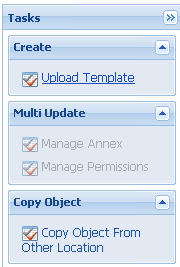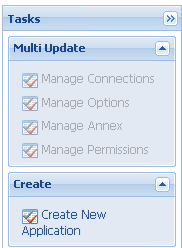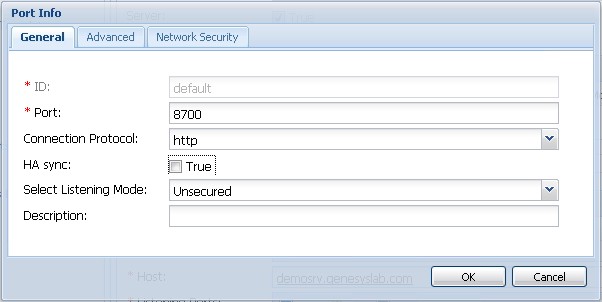Install Genesys Co-browse Server
Contents
Configure the JAVA_HOME environment variable
Before installing Genesys Co-browse Server, you must first make sure your JAVA_HOME environment variable is configured correctly. The value for this variable must not have a slash ("\", "/") at the end. For example, C:\java (Windows) or C:/java (Unix).
For Unix operating systems, the JAVA_HOME environment variable must be defined at the system level to allow Co-browse Server to be started from Genesys Administrator and Solution Control Interface.
For Windows operating systems there is a known bug in Java (http://www.duckware.com/tech/java6msvcr71.html) that you can avoid by completing the following steps:
- Add %JAVA_HOME%\bin to the beginning of the PATH environment variable.
- Make sure java.exe is launched from the %JAVA_HOME%\bin folder.
Next Step
![]() Creating the Co-browse Server Application Object in Genesys Administrator
Creating the Co-browse Server Application Object in Genesys Administrator
Creating the Co-browse Server Application Object in Genesys Administrator
Importing the Application Template for the Co-browse Server
Start of Procedure
- Open Genesys Administrator and navigate to PROVISIONING > Environment > Application Templates.
- In the Create menu of the Tasks panel, click the Upload Template link.
- Click the Add button of the Click 'Add' and choose application template (APD) file to import dialog box.
- Browse to the Co-browse_Server_813.apd file, available in the templates directory of your installation CD. The New Application Template panel opens.
- Click Save & Close.
End of Procedure
Next Step
![]() Creating the Co-browse Server Application
Creating the Co-browse Server Application
Creating the Co-browse Server Application
Prerequisites:
- You must have a webapi listening port configured on your Chat Server Application. For details, refer to the eServices 8.1 Deployment Guide.
- You completed Importing the Application Template for the Co-browse Server.
Start of Procedure
- Open Genesys Administrator and navigate to PROVISIONING > Environment > Applications.
- In the Create menu of the Tasks panel, click the Create New Application link.
- In the Select Application Template panel, click Browse for Template and select the Co-browse Server template that you imported in Importing the Application Template for the Co-browse Server. Click OK.
- The template is added to the Select Application Template panel. Click Next.
- In the Select Metadata file panel, click Browse and select the Co-browse_Server_813.xml file. Click Open.
- The metadata file is added to the Select Metadata file panel. Click Next.
- In Specify Application parameters:
- Enter a Name for your application—for instance, Co-browse_Server.
- Enable the State.
- Select the Host on which Co-browse Server will reside.
- Click Create.
- The Results panel opens.
- Enable Opens the Application details form after clicking 'Finish' and click Finish. The Co-browse Server application form opens to the Configuration tab.
- Add a connection to Chat Server.
- Click Add in the Connections section.
- Select the Chat Server and click OK.
- Edit the connection and set ID to the webapi listening port on your Chat Server.
- Click OK.
- If your Host is not defined, click the lookup icon to browse to the hostname of your application.
- Add the default port.
- Click Add in the Listening Ports section. The Port Info dialog box opens.
- Enter the application's Port. For instance, 8700. This must be a Jetty port configured in the Jetty configuration file.
- Mandatory: Enter http for the Connection Protocol field. This connection protocol setting will be used by IWS to connect to the Co-browse Server.
- Optional: Enter a description.
- Click OK. The HTTP port with the default identifier appears in the list of Listening Ports.
- Add the secure port.
- Click Add in the Listening Ports section. The Port Info dialog box opens.
- Enter https for the ID.
- Enter the application's secure Port. For instance, 8743. This must be a Jetty port configured in the Jetty configuration file.
- Mandatory: Enter https for the Connection Protocol field.
- Mandatory: Select the Secured for the Select Listening Mode field.
- Optional: Enter a description.
- Click OK. The HTTPS port with the https identifier appears in the list of Listening Ports.
- Ensure the Working Directory and Command Line fields contain "." (period). They will be automatically populated when the Co-browse Server is installed.
- Click Save & Close. The Confirm dialog displays the following message: The host and/or port(s) of the application will be changed. Do you want to continue? Click Yes.
End of Procedure
Next Steps
- You can now install the Co-browse Server as described in Installing the Co-browse Server.
Installing the Co-browse Server
With basic Configuration Server details in place, you are ready to complete the installation process.
Prerequisites: You completed Creating the Co-browse Server Application.
Start of Procedure
- In your installation package, locate and run the setup application for your platform as specified below:
- Linux: install.sh
- Windows: setup.exe
- The Install Shield opens the welcome screen.
- Click Next. The Connection Parameters to the Configuration Server screen appears.
- Under Host, specify the host name and port number where Configuration Server is running. (This is the main "listening" port entered in the Server Info tab for Configuration Server.)
- Under User, enter the user name and password for logging on to Configuration Server.
- Click Next. The Select Application screen appears.
- Select the Co-browse Server Application that you are installing. The Application Properties area shows the Type, Host, Working Directory, Command Line executable, and Command Line Arguments information previously entered in the Server Info and Start Info tabs of the selected Application object.
- Click Next. The Choose Destination Location screen appears.
- Under Destination Folder, keep the default value or browse for the desired installation location.
- Click Next. The Backup Configuration Server Parameters screen appears.
- Under Host, specify the host name and the port number where the Backup Configuration Server is running.
- Click Next. The Ready to Install screen appears.
- Click Install. The Genesys Installation Wizard indicates it is performing the requested operation for Co-browse Server. When through, the Installation Complete screen appears.
- Click Finish to complete your installation of Co-browse Server.
End of Procedure
Next Steps
- Complete the configuration of the Co-browse Server Application, as described in Configuring the Co-browse Server.
Configuring the Co-browse Server
![]() Purpose: To configure the Co-browse Server application in Genesys Administrator. This procedure only covers a few of the mandatory options. Most options can be left at their default values.
Purpose: To configure the Co-browse Server application in Genesys Administrator. This procedure only covers a few of the mandatory options. Most options can be left at their default values.
Prerequisites: Creating the Co-browse Server Application.
Start of Procedure
- Open Genesys Administrator and navigate to PROVISIONING > Environment > Applications.
- Select the Co-browse Server Application that you created previously.
- In the Options tab, locate the sessions section and update the following option:
- domRetrictionsURL—a URL that points to the XML file that contains DOM restrictions. Note: By default, all "Submit" buttons are disabled for the agent. For information about customizing this XML file, see DOM Restrictions
- If you deploy Co-browse Server to an environment where the Internet is accessed using a forward proxy (for example, DMZ or local intranet), configure the options in the forward-proxy section.
- If your configuration uses Genesys Chat, update the following options in the chat section:
- queuekey—specifies the endpoint configured in Chat Server, in the format tenantid:endpointname.
- Configure the options in the log section. These options are standard Genesys log options. For details, refer to the Management Framework 8.1 Configuration Options Reference Manual.
- Click Save & Close.
End of Procedure
Next Steps





